What's a Virus? Viral Infection Types, Symptoms, Treatment
What Is a Virus?
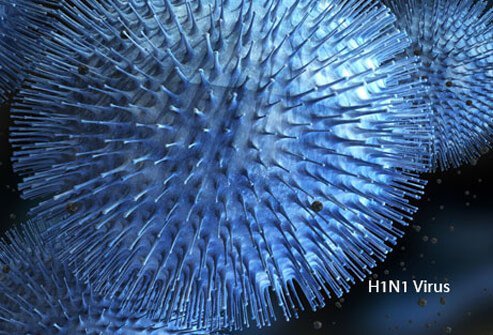
Viruses are small particles of genetic material (either DNA or RNA) that are surrounded by a protein coat. Some viruses also have a fatty "envelope" covering. They are incapable of reproducing on their own. Viruses depend on the organisms they infect (hosts) for their very survival. Viruses get a bad rap, but they also perform many important functions for humans, plants, animals, and the environment. For example, some viruses protect the host against other infections. Viruses also participate in the process of evolution by transferring genes among different species. In biomedical research, scientists use viruses to insert new genes into cells.
When most people hear the word "virus," they think of disease-causing (pathogenic) viruses such as the common cold, influenza, chickenpox, human immunodeficiency virus (HIV), SARS-CoV-2 and others. Viruses can affect many areas in the body, including the reproductive, respiratory, and gastrointestinal systems. They can also affect the liver, brain, and skin. Research reveals that viruses are implicated in many cancers as well.
What Is a Viral Infection?
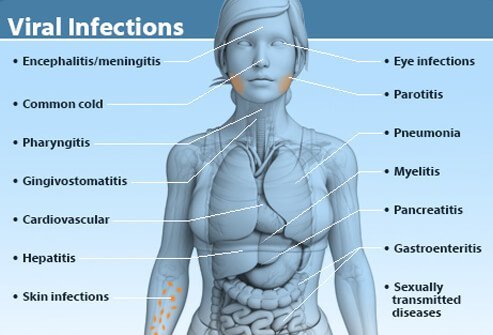
A viral infection is a proliferation of a harmful virus inside your body. Viruses cannot reproduce without the assistance of a host. Viruses infect a host by introducing their genetic material into the cells and hijacking the cell's internal machinery to make more virus particles. With an active viral infection, a virus makes copies of itself and bursts the host cell (killing it) to set the newly-formed virus particles free. In other cases, virus particles "bud" off the host cell over a period of time before killing the host cell. Either way, new virus particles are then free to infect other cells. Symptoms of the viral illness occur as a result of cell damage, tissue destruction, and the associated immune response.
Certain viruses -- like the ones that cause chickenpox and cold sores -- may be inactive or “latent” after the initial infection. For example, you may have a cold sore that erupts and then heals. The cold sore virus remains in your cells in a dormant state. Later, a trigger like stress, sunlight, or something else, may reactivate the virus and lead to new symptoms. The virus makes more copies of itself, releases new virus particles, and kills more host cells.
Are Viruses Alive?
Microbiologists still disagree. Those who say viruses are alive offer these reasons:
- They make copies of themselves to regenerate.
- They acquire energy (from their hosts).
Reasons some say viruses are not alive:
- They have no cells (only protein coatings surrounding genetic material).
- They don't reproduce by themselves; they need host cells.
And one thing still undecided—do viruses respond to their environment? It's hard to say. Some argue that they do not, while others say they do. It may depend on a person's own definition of "life."
How Long Are Viral Infections Contagious?
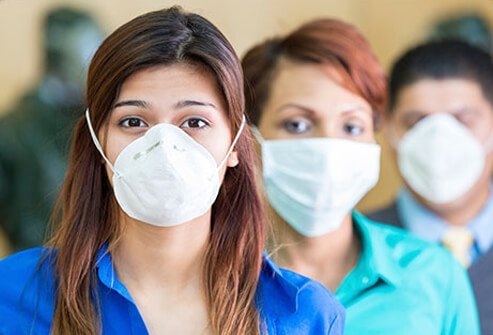
Contagiousness refers to the ability of a virus to be transmitted from one person (or host) to another. Viral infections are contagious for varying periods of time depending on the virus. An incubation period refers to the time between exposure to a virus (or other pathogen) and the emergence of symptoms. The contagious period of a virus is not necessarily the same as the incubation period.
Is it a Bacterial or Viral Infection?
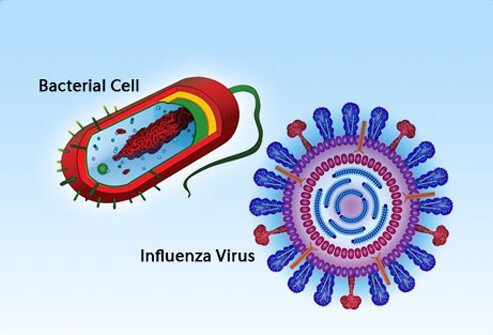
Viruses and bacteria are two types of potentially disease-causing (pathogenic) particles. Viruses are much smaller than bacteria and can't reproduce without the assistance of a host. Bacteria are capable of reproducing on their own. The symptoms of viral and bacterial illnesses are sometimes similar. A doctor can determine the underlying cause of an illness based on the patient's symptoms and other factors. Lab tests may help clarify whether an illness is due to a virus, bacteria, or other infectious agent or disease process.
Note that the drawing of influenza virus is enlarged; most viruses are much smaller than bacteria.
Virus Transmission
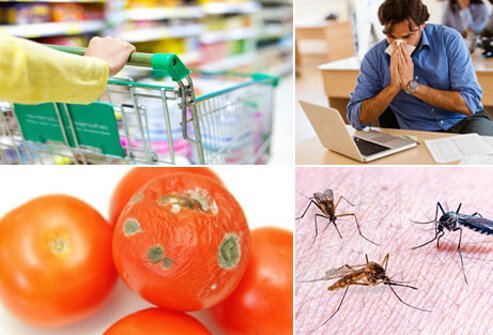
Viruses can be transmitted in a variety of ways. Some viruses can spread through touch, saliva, or even the air. Other viruses can be transmitted through sexual contact or by sharing contaminated needles. Insects including ticks and mosquitoes can act as "vectors," transmitting a virus from one host to another. Contaminated food and water are other potential sources of viral infection.
Respiratory Viral Infections
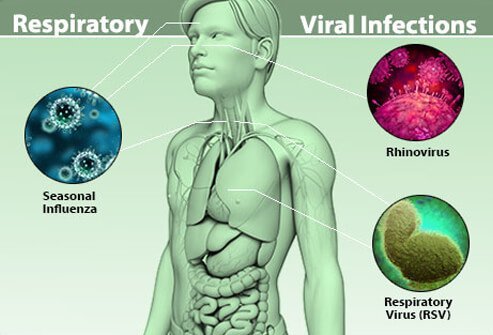
Respiratory viral infections affect the lungs, nose, and throat. These viruses are most commonly spread by inhaling droplets containing virus particles. Examples include:
- Rhinovirus is the virus that most often causes the common cold, but there are more than 200 different viruses that can cause colds. Cold symptoms like coughing, sneezing, mild headache, and sore throat typically last for up to 2 weeks.
- Seasonal influenza is an illness that affects about 5% to 20% of the population in the US every year. More than 200,000 people per year are hospitalized annually in the US due to complications of the flu. Flu symptoms are more severe than cold symptoms and often include body aches and severe fatigue. The flu also tends to come on more suddenly than a cold.
- Respiratory Syncytial Virus (RSV) is an infection that can cause both upper respiratory infections (like colds) and lower respiratory infections (like pneumonia and bronchiolitis). It can be very severe in infants, small children, and elderly adults.
- SARS-COV-2 is a respiratory coronavirus that causes COVID-19 infection. COVID-19 caused a global pandemic in 2020, shutting down schools, businesses, and public life in nations across the world, infecting millions of people and killing over 1 million worldwide and 210,000 in the US as of early Fall. The first reports of this virus came from Wuhan, China in Dec. 2019. Symptoms include cough, fever, shortness of breath, and pneumonia.
Frequent hand-washing, covering the nose and mouth when coughing or sneezing, and avoiding contact with infected individuals can all reduce the spread of respiratory infections. Disinfecting hard surfaces and not touching the eyes, nose, and mouth can help reduce transmission as well.
Wearing a mask when going out of your home and keeping away from groups of individuals inside buildings (social distancing – staying at least 6 feet apart from others) may decrease your chances of getting such viral infections as the flu and COVID-19.
Viral Skin Infections

Viral skin infections can range from mild to severe and often produce a rash. Examples of viral skin infections include:
- Molluscum contagiosum causes small, flesh-colored bumps most often in children ages 1 to 10 years old; however, people of any age can acquire the virus. The bumps usually disappear without treatment, usually in 6 to 12 months.
- Herpes simplex virus-1 (HSV-1) is the common virus that causes cold sores. It's transmitted through saliva by kissing or sharing food or drink with an infected individual. Sometimes, HSV-1 causes genital herpes. An estimated 85% of people in the US have HSV-1 by the time they are in their 60s.
- Varicella-zoster virus (VZV) causes itchy, oozing blisters, fatigue, and high fever characteristic of chickenpox. The chickenpox vaccine is 98% effective at preventing infection. People who have had chickenpox (or in extremely rare instances, people who have received the chickenpox vaccine) are at risk for developing shingles, an illness caused by the same virus. Shingles can occur at any age, but it occurs most often in people age 60 or older.
The best way to avoid viral skin infections is to avoid skin-to-skin contact (especially areas that have a rash or sores) with an infected individual. Some viral skin infections, such as varicella-zoster virus, are also transmitted by an airborne route. Communal showers, swimming pools, and contaminated towels can also potentially harbor certain viruses.
Viral Food Poisoning

Viruses are one of the most common causes of food poisoning. The symptoms of these infections vary depending on the virus involved.
- Hepatitis A is a virus that affects the liver for a few weeks up to several months. Symptoms may include yellow skin, nausea, diarrhea, and vomiting. Up to 15% of infected individuals experience recurrent illness within 6 months of infection.
- Norovirus has been reported to be responsible for outbreaks of severe gastrointestinal illness that happen on cruise ships, but it causes disease in many situations and locations. About 20 million people in the U.S. become sick from these highly contagious viruses every year.
- Rotavirus causes severe, watery diarrhea that can lead to dehydration. Anyone can get rotavirus, but the illness occurs most often in babies and young children.
Rotaviruses and noroviruses are responsible for many (but not all) cases of viral gastroenteritis, which causes inflammation of the stomach and intestines. People may use the terms "stomach virus" or "stomach flu" to refer to viral gastroenteritis, which causes nausea, vomiting, diarrhea, and abdominal pain.
It's not pleasant to think about it, but foodborne viral illnesses are transmitted via the fecal-oral route. This means that a person gets the virus by ingesting virus particles that were shed through the feces of an infected person. Someone with this type of virus who doesn't wash their hands after using the restroom can transfer the virus to others by shaking hands, preparing food, or touching hard surfaces. Contaminated water is another potential source of infection.
Viral Infections & STIs
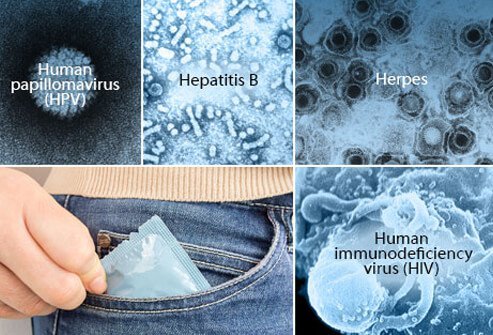
Sexually transmitted viral infections spread through contact with bodily fluids. Some sexually transmitted infections can also be transmitted via the blood (blood-borne transmission).
- Human papillomavirus (HPV) is the most common sexually-transmitted infection in the US. There are many different types of HPV. Some cause genital warts while others increase the risk of cervical cancer. Vaccination can protect against cancer-causing strains of HPV.
- Hepatitis B is a virus that causes inflammation in the liver. It's transmitted through contaminated blood and bodily fluids. Some people with the virus don't have any symptoms while others feel like they have the flu. The hepatitis B vaccine is more than 90% effective at preventing infection.
- Genital herpes is a common sexually-transmitted infection caused by herpes simplex virus-2 (HSV-2). Herpes simplex virus-1 (HSV-1), the virus responsible for cold sores, can also sometimes cause genital herpes. There's no cure for genital herpes. Painful sores often recur during outbreaks. Antiviral medications can decrease both the number and length of outbreaks.
- Human immunodeficiency virus (HIV) is a virus that affects certain types of T cells of the immune system. Progression of the infection decreases the body's ability to fight disease and infection, leading to acquired immune deficiency syndrome (AIDS). HIV is transmitted by contacting blood or bodily fluids of an infected person.
People can reduce the risk of getting a sexually-transmitted viral infection by abstaining from sex or only having sex while in a monogamous relationship with someone who does not have a sexually-transmitted infection. Using a condom decreases, but doesn't entirely eliminate, the risk of acquiring a sexually-transmitted infection. Minimizing the number of sexual partners and avoiding intravenous drug use are other ways to reduce the risk of acquiring sexually-transmitted and bloodborne viral infections.
Other Viral Infections
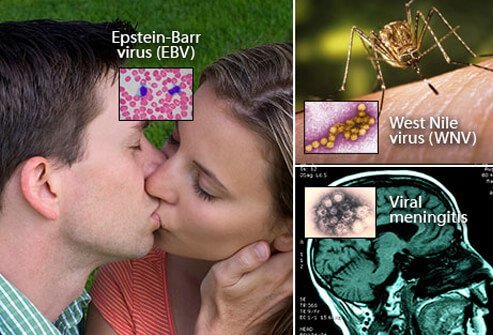
Viruses are abundant in the world and cause many other infections ranging from mild to life-threatening.
- Epstein-Barr virus (EBV) is a type of herpes virus that's associated with fever, fatigue, swollen lymph nodes, and an enlarged spleen. EBV is a very common virus that causes mononucleosis ("mono"). More than 90% of adults have been infected with this "kissing disease" that is spread primarily through saliva.
- West Nile virus (WNV) is a virus that's most commonly transmitted by infected mosquitos. Most people (70% to 80%) with WNV don't have any symptoms while others develop a fever, headache, and other symptoms. Less than 1% of people with WNV develop inflammation of the brain (encephalitis) or inflammation of the tissue surrounding the brain and spinal cord (meningitis).
- Viral meningitis is an inflammation of the lining of the brain and spinal cord that causes headache, fever, stiff neck, and other symptoms. Many viruses can cause viral meningitis, but a group of viruses called enteroviruses are most often to blame.
Antiviral Medication and Other Treatment

Many viral infections resolve on their own without treatment. Other times, treatment of viral infections focuses on symptom relief, not fighting the virus. For example, cold medicine helps alleviate the pain and congestion associated with the cold, but it doesn't act directly on the cold virus.
There are some medications that work directly on viruses. These are called antiviral medications. They work by inhibiting the production of virus particles. Some interfere with the production of viral DNA. Others prevent viruses from entering host cells. There are other ways in which these medications work. In general, antiviral medications are most effective when they're taken early on in the course of an initial viral infection or a recurrent outbreak. Different kinds of antiviral medications may be used to treat chickenpox, shingles, herpes simplex virus-1 (HSV-1), herpes simplex virus-2 (HSV-2), HIV, hepatitis B, hepatitis C, and influenza.
Viruses and Cancer
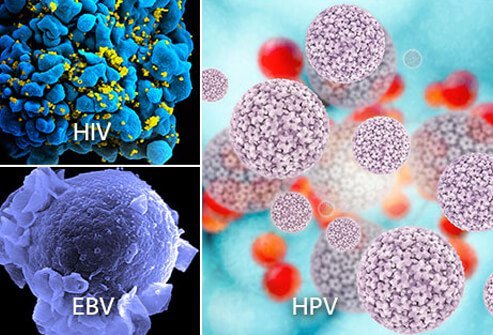
Viruses insert themselves into host cell DNA in order to make more virus particles. Cancer is a disease that occurs as the result of mutations or alterations to DNA. Because viruses affect the DNA of host cells, viruses are known to contribute to several different types of cancer. Viruses known to increase the risk of cancer include:
- Epstein-Barr virus (EBV) for nasopharyngeal cancer, Burkitt lymphoma, Hodgkin's lymphoma, and stomach cancer
- Hepatitis B and hepatitis C for liver cancer
- Human immunodeficiency virus (HIV) for Kaposi sarcoma, invasive cervical cancer, lymphomas, and other cancers
- Human T-lymphotropic virus-1 (HTLV-1) for T-cell leukemia/lymphoma (ATL)
- Human papilloma virus (HPV) for cervical cancer
- Merkel cell polyomavirus (MCV) for a rare skin cancer called Merkel cell carcinoma
Viral Illness Prevention

Vaccines can reduce the risk of acquiring some viral illnesses. Vaccines are available to help protect against the flu, hepatitis A, hepatitis B, chickenpox, herpes zoster (shingles), cancer-causing strains of human papillomavirus (HPV), measles/mumps/rubella (MMR), polio, rabies, rotavirus, and other viruses.
Vaccines vary in effectiveness and in the number of doses required to confer protection. Some vaccines require booster shots to maintain immunity.
What's a Virus? Viral Infection Types, Symptoms, Treatment
IMAGES PROVIDED BY:
- iStockPhoto
- iStockPhoto
MedicineNet - iStockPhoto
- Mariana Ruiz Villarreal / BigStock
- iStockPhoto
Getty Images - iStockPhoto
Getty Images
MedicineNet - E van Herk from NL
iStockPhoto
BigStock - iStockPhoto
- iStockPhoto
NIH-Visuals
George Chernilevsky
CDC / C. Goldsmith
CDC / Dr. Erskine Palmer - CDC / P.E. Rollin / Cynthia Goldsmith
CDC / Ed Uthman, MD
iStockPhoto
MedicineNet - iStockPhoto
- iStockPhoto
Analytical Imaging Facility at the Albert Einstein College of Medicine
National Institutes of Health (NIH) - iStockPhoto
REFERENCES:
- AIDS.gov: "Overview of HIV Treatments."
- Alberts, B., et al. "Introductions to Pathogens." Molecular Biology of the Cell. 4th Edition. 2002.
- American Cancer Society: "Viruses."
- American Society for Microbiology. Microbe World: "Viruses."
- CDC: "About Epstein-Barr Virus (EBV)," "Chickenpox (Varicella)," "Common Cold and Runny Nose," "Genital Herpes -- CDC Fact Sheet," "Glossary of Epidemiology Terms," "Hepatitis B FAQs for the Public," "HIV/AIDS," "Influenza Antiviral Medications: Summary for Clinicians," "Molluscum (Molluscum Contagiosum)," "Respiratory Syncytial Virus Infection (RSV)," "Seasonal Influenza: Flu Basics," "Seasonal Influenza Q&A," "Sexually Transmitted Diseases (STDs)," "Shingles (Herpes Zoster)," "U.S. Vaccines 2012," "Viral Meningitis," "West Nile Virus."
- FoodSafety.gov: "Bacteria and Viruses."
- Janniger, C. K., et al. "Herpes Zoster Treatment & Management." Medscape. 28 Apr. 2014.
- Kimberlin, D. W. and R. J. Whitley. “Antiviral Therapy of HSV-1 and -2.” Human Herpesviruses: Biology, Therapy, and Immunoprophylaxis Cambridge: Cambridge University Press; 2007.
- Lodish, H., et al. "Viruses: Structure, Function, and Uses." Molecular Cell Biology. 4th Edition. 2000.
- Microbiology Online: "Routes of Transmission."
- NHS Choices: "What Are the Incubation Periods For Infections?"
- Pyrsopoulos, N. T., et al. "Hepatitis B Treatment & Management." Medscape. 7 Oct. 2013.
- Roossinck, M. J. "The Good Viruses: Viral Mutualistic Symbiosis." Nature Reviews Microbiology 9.2 (2011): 99-108.
- University of Maryland Medical Center: "Herpes Simplex Virus."
- University of Rochester Medical Center: "Is It a Virus or a Bacterium? Know the Difference."
- Virus Pathogen Database and Analysis Resource: "SARS-CoV-2."
© 1996-2022 WebMD, LLC. All rights reserved.
Source slideshow on OnHealth

